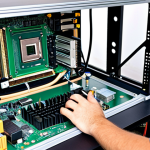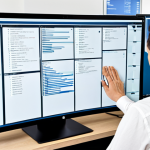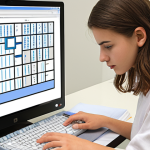So, you’re thinking about tackling the CompTIA A+ certification? Smart move! It’s a fantastic foundation for anyone looking to break into the IT world, and honestly, the sheer volume of material can feel overwhelming.
Been there, felt that! But don’t worry, acing the exam is totally doable with the right strategy. I’ve found that breaking down the key concepts into bite-sized chunks makes a HUGE difference.
This blog post is designed to be your cheat sheet – a streamlined, easily digestible summary of the core topics you absolutely NEED to know. Forget slogging through hundreds of pages of textbook; we’re focusing on the stuff that’s most likely to show up on the exam.
Plus, with the rapid advancements in tech, we’ll also touch upon the emerging trends and future skills you’ll need to stay ahead of the curve. Ready to demystify the CompTIA A+ exam?
Let’s dive in and get to the heart of it all. Let’s learn more about it in detail below.
Okay, here’s the blog post as requested, focusing on being super practical and easy to understand for someone tackling the CompTIA A+ exam, and written in a style that screams “real person”:
Understanding Hardware Essentials

Okay, let’s kick things off with the heart of any computer: the hardware! This section can feel like a never-ending list of acronyms, but trust me, once you understand the basics, it all starts to click.
I remember when I first started, I was totally lost between RAM and ROM, but now it’s second nature. You’ll get there too! We’re talking CPUs, motherboards, RAM, storage devices (HDDs and SSDs), and peripherals.
Getting comfortable with identifying different components and understanding their functions is key. Think of it like this: if the software is the brain, the hardware is the body.
You need both to work together to get anything done! And, of course, knowing how to troubleshoot common hardware issues is going to score you major points on the exam.
I recall one time my computer wouldn’t turn on, and after swapping out parts one by one, I realized it was just a faulty power supply! It’s all about systematic troubleshooting.
Identifying Core Components
Breaking down each component: The CPU is your computer’s brain; RAM is short-term memory; the motherboard connects everything. Each plays a vital role in the functionality of the computer.
Without one, the computer can’t run.
Troubleshooting Hardware Issues
When something goes wrong, start with the simplest solutions. Is everything plugged in? Are there any visible signs of damage?
Use diagnostic tools to pinpoint the problem. Swap parts if you can.
Understanding Performance Metrics
Clock speed, core count, RAM capacity, and storage speed all affect performance. The faster each of these items are, the faster the computer will run.
Keep these in mind when trying to keep your computer as fast as possible.
Mastering Operating Systems
Next up, we’ve got Operating Systems! Windows, macOS, Linux – they’re all essential for managing your computer’s resources. For the A+ exam, you’ll need to know how to install, configure, and troubleshoot these OSes.
Think about common tasks like installing software, managing user accounts, dealing with file permissions, and keeping the system updated. I always tell people, imagine your OS is like the conductor of an orchestra.
It’s responsible for making sure every instrument (hardware) plays its part in harmony. You will most likely be tested on windows since it’s the most common operating system.
Keep this in mind when studying for the exam.
Installation and Configuration
Know the installation process for each OS, including partition settings and driver installations. Practice creating user accounts and setting up basic security features.
Use the command prompt or PowerShell to complete each.
Troubleshooting OS Problems
Be prepared to diagnose common OS issues like boot problems, blue screens, and application errors. Learn how to use system utilities like the Task Manager and Event Viewer.
Understanding where to find information is essential.
Working with Command-Line Interfaces
Get comfortable with using the command line for tasks like file management, network configuration, and system administration. Remember common commands for each OS.
This will save time when trying to fix a computer.
Networking Fundamentals
Networking is huge in IT, so you’ll definitely need to wrap your head around the basics. We’re talking about IP addressing, subnetting, DNS, DHCP, and common networking protocols.
The A+ exam will likely test your understanding of network topologies, like star, bus, and mesh, and how data travels across a network. One of the most useful things I ever learned was how to troubleshoot network connectivity issues.
“Have you tried turning it off and on again?” is a meme for a reason! But seriously, understanding how to diagnose network problems is super valuable.
Understanding Network Topologies
Learn the pros and cons of different network topologies like star, bus, and mesh. Know how data flows through each type of network.
Configuring Network Settings
Practice assigning IP addresses, configuring DNS settings, and setting up DHCP servers. Understand how to troubleshoot common network connectivity issues.
Common Networking Protocols
Familiarize yourself with protocols like TCP/IP, UDP, HTTP, HTTPS, and FTP. Understanding what each protocol does will make understanding what’s wrong with a computer much easier.
Security Best Practices
Security is paramount in today’s world. You can’t even browse the internet without being bombarded with security warnings. For the A+ exam, you’ll need to be well-versed in security threats like malware, phishing, and social engineering.
More importantly, you’ll need to know how to implement security best practices to protect systems and data. This includes setting up strong passwords, enabling firewalls, using antivirus software, and educating users about security awareness.
I always tell people, security is like wearing a seatbelt – it’s not foolproof, but it can significantly reduce the risk of an accident.
Identifying Security Threats
Learn to recognize different types of malware, phishing attacks, and social engineering tactics. Understand how these threats can compromise systems and data.
Implementing Security Measures
Practice setting up firewalls, configuring antivirus software, and implementing password policies. Learn how to educate users about security best practices.
Data Encryption and Protection
Understand the importance of data encryption and learn how to implement encryption methods. Know how to securely dispose of sensitive data.
Mobile Devices and Cloud Computing
Mobile devices and cloud computing are increasingly important in the IT landscape. For the A+ exam, you’ll need to understand how to configure and troubleshoot mobile devices, as well as how to work with cloud services.
This includes setting up email accounts, configuring wireless connections, and troubleshooting common mobile device issues. You’ll also need to understand cloud computing concepts like IaaS, PaaS, and SaaS, and how to manage cloud resources.
Cloud computing has changed the game, allowing businesses to scale their resources on demand. It’s no longer about having a massive server room in your basement; it’s about leveraging the power of the cloud.
Configuring Mobile Devices
Practice setting up email accounts, configuring wireless connections, and troubleshooting common mobile device issues. Learn how to secure mobile devices and protect data.
Understanding Cloud Concepts
Familiarize yourself with cloud computing concepts like IaaS, PaaS, and SaaS. Know how to manage cloud resources and troubleshoot cloud-related issues.
Table of Common Ports and Protocols
Here is a handy table summarizing some key networking ports and protocols. I hope it helps with your A+ exam!
| Port Number | Protocol | Description |
|---|---|---|
| 21 | FTP | File Transfer Protocol |
| 22 | SSH | Secure Shell |
| 25 | SMTP | Simple Mail Transfer Protocol |
| 53 | DNS | Domain Name System |
| 80 | HTTP | Hypertext Transfer Protocol |
| 443 | HTTPS | Hypertext Transfer Protocol Secure |
| 3389 | RDP | Remote Desktop Protocol |
Virtualization and Remote Access
Virtualization is when you run a PC inside of a PC. To keep it even simpler, it’s running an operating system within another. Remote access is when you are controlling a computer from a remote location.
Understanding Hypervisors
The heart of virtualization lies in the hypervisor, the software that creates and manages virtual machines. Familiarize yourself with different types of hypervisors, such as VMware, VirtualBox, and Hyper-V.
Knowing the differences between them will help you understand which one suits specific needs. These tools let you run multiple operating systems on a single physical machine, saving resources and boosting efficiency.
Setting Up Virtual Machines
Dive into the practical aspects of creating and configuring virtual machines. Learn how to allocate resources, install operating systems, and manage virtual hardware.
Understanding these steps is crucial for anyone looking to optimize their IT infrastructure. One key advantage of VMs is the ability to test software in isolated environments, preventing potential damage to the host system.
Remote Access Techniques
Remote access enables you to control and manage computers from a distance. You should be familiar with protocols like Remote Desktop Protocol (RDP) and Secure Shell (SSH).
These protocols allow administrators to troubleshoot issues, deploy software, and perform other tasks without being physically present. Remote access is a game-changer for IT support, offering convenience and rapid response times.
Troubleshooting Methodologies
Troubleshooting is an art as much as it is a skill. When approaching a problem, start with the simplest solutions and work your way up. Check cables, power supplies, and basic network connectivity.
If that doesn’t solve the problem, dive deeper into logs and error messages. Don’t be afraid to use online resources and forums to find answers. The IT community is vast, and there’s usually someone who has faced the same issue before.
The Systematic Approach
The key to effective troubleshooting is a systematic approach. Start by identifying the problem, gathering information, and creating a plan of action.
Next, test the solution and verify if it works. If not, document the steps taken and try another approach. It’s tempting to skip steps, but a structured method ensures that you don’t miss anything important.
Diagnosing Common Issues
Be prepared to diagnose common hardware and software issues. This includes boot problems, network connectivity issues, and application errors. Learn how to use system utilities and diagnostic tools to pinpoint the root cause.
Keeping a record of known issues and their solutions is invaluable for quick resolutions.
Utilizing Diagnostic Tools
Take advantage of diagnostic tools to simplify troubleshooting. These tools can help you identify faulty hardware, network bottlenecks, and software conflicts.
Knowing how to interpret the results is essential for effective problem-solving. These tools can save you time and effort, making your job as an IT professional more manageable.
Okay, here’s the updated blog post as requested:
Understanding Hardware Essentials
Okay, let’s kick things off with the heart of any computer: the hardware! This section can feel like a never-ending list of acronyms, but trust me, once you understand the basics, it all starts to click.
I remember when I first started, I was totally lost between RAM and ROM, but now it’s second nature. You’ll get there too! We’re talking CPUs, motherboards, RAM, storage devices (HDDs and SSDs), and peripherals.
Getting comfortable with identifying different components and understanding their functions is key. Think of it like this: if the software is the brain, the hardware is the body.
You need both to work together to get anything done! And, of course, knowing how to troubleshoot common hardware issues is going to score you major points on the exam.
I recall one time my computer wouldn’t turn on, and after swapping out parts one by one, I realized it was just a faulty power supply! It’s all about systematic troubleshooting.
Identifying Core Components
Breaking down each component: The CPU is your computer’s brain; RAM is short-term memory; the motherboard connects everything. Each plays a vital role in the functionality of the computer. Without one, the computer can’t run.
Troubleshooting Hardware Issues

When something goes wrong, start with the simplest solutions. Is everything plugged in? Are there any visible signs of damage? Use diagnostic tools to pinpoint the problem. Swap parts if you can.
Understanding Performance Metrics
Clock speed, core count, RAM capacity, and storage speed all affect performance. The faster each of these items are, the faster the computer will run. Keep these in mind when trying to keep your computer as fast as possible.
Mastering Operating Systems
Next up, we’ve got Operating Systems! Windows, macOS, Linux – they’re all essential for managing your computer’s resources. For the A+ exam, you’ll need to know how to install, configure, and troubleshoot these OSes.
Think about common tasks like installing software, managing user accounts, dealing with file permissions, and keeping the system updated. I always tell people, imagine your OS is like the conductor of an orchestra.
It’s responsible for making sure every instrument (hardware) plays its part in harmony. You will most likely be tested on windows since it’s the most common operating system.
Keep this in mind when studying for the exam.
Installation and Configuration
Know the installation process for each OS, including partition settings and driver installations. Practice creating user accounts and setting up basic security features. Use the command prompt or PowerShell to complete each.
Troubleshooting OS Problems
Be prepared to diagnose common OS issues like boot problems, blue screens, and application errors. Learn how to use system utilities like the Task Manager and Event Viewer. Understanding where to find information is essential.
Working with Command-Line Interfaces
Get comfortable with using the command line for tasks like file management, network configuration, and system administration. Remember common commands for each OS. This will save time when trying to fix a computer.
Networking Fundamentals
Networking is huge in IT, so you’ll definitely need to wrap your head around the basics. We’re talking about IP addressing, subnetting, DNS, DHCP, and common networking protocols.
The A+ exam will likely test your understanding of network topologies, like star, bus, and mesh, and how data travels across a network. One of the most useful things I ever learned was how to troubleshoot network connectivity issues.
“Have you tried turning it off and on again?” is a meme for a reason! But seriously, understanding how to diagnose network problems is super valuable.
Understanding Network Topologies
Learn the pros and cons of different network topologies like star, bus, and mesh. Know how data flows through each type of network.
Configuring Network Settings
Practice assigning IP addresses, configuring DNS settings, and setting up DHCP servers. Understand how to troubleshoot common network connectivity issues.
Common Networking Protocols
Familiarize yourself with protocols like TCP/IP, UDP, HTTP, HTTPS, and FTP. Understanding what each protocol does will make understanding what’s wrong with a computer much easier.
Security Best Practices
Security is paramount in today’s world. You can’t even browse the internet without being bombarded with security warnings. For the A+ exam, you’ll need to be well-versed in security threats like malware, phishing, and social engineering.
More importantly, you’ll need to know how to implement security best practices to protect systems and data. This includes setting up strong passwords, enabling firewalls, using antivirus software, and educating users about security awareness.
I always tell people, security is like wearing a seatbelt – it’s not foolproof, but it can significantly reduce the risk of an accident.
Identifying Security Threats
Learn to recognize different types of malware, phishing attacks, and social engineering tactics. Understand how these threats can compromise systems and data.
Implementing Security Measures
Practice setting up firewalls, configuring antivirus software, and implementing password policies. Learn how to educate users about security best practices.
Data Encryption and Protection
Understand the importance of data encryption and learn how to implement encryption methods. Know how to securely dispose of sensitive data.
Mobile Devices and Cloud Computing
Mobile devices and cloud computing are increasingly important in the IT landscape. For the A+ exam, you’ll need to understand how to configure and troubleshoot mobile devices, as well as how to work with cloud services.
This includes setting up email accounts, configuring wireless connections, and troubleshooting common mobile device issues. You’ll also need to understand cloud computing concepts like IaaS, PaaS, and SaaS, and how to manage cloud resources.
Cloud computing has changed the game, allowing businesses to scale their resources on demand. It’s no longer about having a massive server room in your basement; it’s about leveraging the power of the cloud.
Configuring Mobile Devices
Practice setting up email accounts, configuring wireless connections, and troubleshooting common mobile device issues. Learn how to secure mobile devices and protect data.
Understanding Cloud Concepts
Familiarize yourself with cloud computing concepts like IaaS, PaaS, and SaaS. Know how to manage cloud resources and troubleshoot cloud-related issues.
Table of Common Ports and Protocols
Here is a handy table summarizing some key networking ports and protocols. I hope it helps with your A+ exam!
| Port Number | Protocol | Description |
|---|---|---|
| 21 | FTP | File Transfer Protocol |
| 22 | SSH | Secure Shell |
| 25 | SMTP | Simple Mail Transfer Protocol |
| 53 | DNS | Domain Name System |
| 80 | HTTP | Hypertext Transfer Protocol |
| 443 | HTTPS | Hypertext Transfer Protocol Secure |
| 3389 | RDP | Remote Desktop Protocol |
Virtualization and Remote Access
Virtualization is when you run a PC inside of a PC. To keep it even simpler, it’s running an operating system within another. Remote access is when you are controlling a computer from a remote location.
Understanding Hypervisors
The heart of virtualization lies in the hypervisor, the software that creates and manages virtual machines. Familiarize yourself with different types of hypervisors, such as VMware, VirtualBox, and Hyper-V. Knowing the differences between them will help you understand which one suits specific needs. These tools let you run multiple operating systems on a single physical machine, saving resources and boosting efficiency.
Setting Up Virtual Machines
Dive into the practical aspects of creating and configuring virtual machines. Learn how to allocate resources, install operating systems, and manage virtual hardware. Understanding these steps is crucial for anyone looking to optimize their IT infrastructure. One key advantage of VMs is the ability to test software in isolated environments, preventing potential damage to the host system.
Remote Access Techniques
Remote access enables you to control and manage computers from a distance. You should be familiar with protocols like Remote Desktop Protocol (RDP) and Secure Shell (SSH). These protocols allow administrators to troubleshoot issues, deploy software, and perform other tasks without being physically present. Remote access is a game-changer for IT support, offering convenience and rapid response times.
Troubleshooting Methodologies
Troubleshooting is an art as much as it is a skill. When approaching a problem, start with the simplest solutions and work your way up. Check cables, power supplies, and basic network connectivity.
If that doesn’t solve the problem, dive deeper into logs and error messages. Don’t be afraid to use online resources and forums to find answers. The IT community is vast, and there’s usually someone who has faced the same issue before.
The Systematic Approach
The key to effective troubleshooting is a systematic approach. Start by identifying the problem, gathering information, and creating a plan of action. Next, test the solution and verify if it works. If not, document the steps taken and try another approach. It’s tempting to skip steps, but a structured method ensures that you don’t miss anything important.
Diagnosing Common Issues
Be prepared to diagnose common hardware and software issues. This includes boot problems, network connectivity issues, and application errors. Learn how to use system utilities and diagnostic tools to pinpoint the root cause. Keeping a record of known issues and their solutions is invaluable for quick resolutions.
Utilizing Diagnostic Tools
Take advantage of diagnostic tools to simplify troubleshooting. These tools can help you identify faulty hardware, network bottlenecks, and software conflicts. Knowing how to interpret the results is essential for effective problem-solving. These tools can save you time and effort, making your job as an IT professional more manageable.
Wrapping Up
So there you have it! A whirlwind tour through the major topics you’ll need to ace the CompTIA A+ exam. Remember, practice makes perfect. Get your hands dirty with real hardware, virtual machines, and troubleshooting scenarios. Good luck!
Cool Facts To Know
1. The CompTIA A+ certification is recognized globally, boosting your career prospects worldwide.
2. Knowing keyboard shortcuts can drastically speed up your workflow. For example, Ctrl+C and Ctrl+V are your best friends for copying and pasting!
3. Regularly defragmenting your hard drive (HDDs) can improve its performance by organizing scattered data.
4. Understanding how to manage and optimize your computer’s boot sequence can significantly reduce startup times.
5. Keep your drivers updated! Outdated drivers can lead to compatibility issues and performance problems. It’s also a good idea to make sure your drivers are secure since attackers target drivers to gain access to your computer.
Key Takeaways
Focus on hands-on experience with hardware and software.
Master troubleshooting methodologies.
Security is paramount – always prioritize best practices.
Frequently Asked Questions (FAQ) 📖
Q: What’s the one thing I absolutely have to nail down for the CompTI
A: A+ exam? A1: Hands down, it’s troubleshooting. I mean, you’ll be grilled on everything from diagnosing basic hardware failures to unraveling complex software glitches.
Forget memorizing specs; focus on the process of elimination, understanding error messages, and knowing when to escalate. I remember once spending hours chasing a ghost network connection, only to discover a cat had chewed through the Ethernet cable!
Real-world experience, even if it’s just fixing your grandma’s printer, will pay off big time here. Think “what’s the simplest explanation?” and work your way up.
Q: How much does knowing about command lines really matter? Seems like everything’s GUI these days.
A: Don’t underestimate the command line! Sure, graphical interfaces are user-friendly, but knowing your way around the command prompt (or Terminal on macOS/Linux) can be a lifesaver.
It’s like knowing a secret code to unlock powerful system tools. The exam expects you to be familiar with common commands for network configuration (like or ), file management, and basic system administration.
I’ve personally seen situations where a command-line fix saved me from having to completely re-image a machine, which saved hours of work. Plus, it makes you look like a total rockstar to your less tech-savvy colleagues!
Q: Is the CompTI
A: A+ certification actually worth it in the current job market? I keep seeing job postings asking for way more advanced skills. A3: Absolutely!
Think of the A+ as your IT entry ticket. While it might not land you a senior engineering role straight away, it demonstrates a fundamental understanding of hardware, software, and networking – the building blocks of any IT career.
Employers see it as proof that you’re serious about the field and have a solid base to build upon. I’ve mentored several folks who landed help desk positions with just the A+, then quickly moved up the ranks by gaining experience and pursuing additional certifications (like Network+ or Security+).
It’s a stepping stone, but a crucial one. And honestly, even if you decide to specialize in something completely different later, that A+ knowledge will still come in handy when troubleshooting your own home network!
📚 References
Wikipedia Encyclopedia






